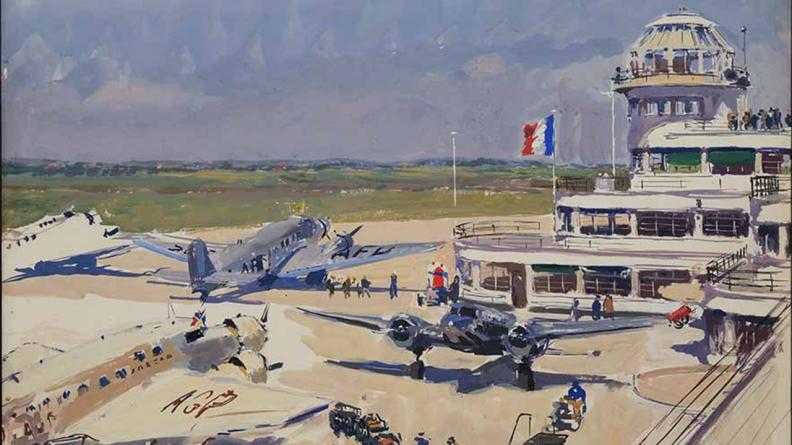Some of you might have seen the film on Rudolf Nureev’s defection to France, which took place at le Bourget airport on June 16, 1961. He had come to Paris to dance with 100 dancers from the Kirov for a month and as the group was going to London, he was being sent back to Moscow supposedly for a benefit. He decided to request political asylum and went straight up to the police at the airport. When I walked into the Museum Air and Space to see the new exhibition devoted to “Les Années folles de l’Aviation” (Années folles of flying), I thought of him, and the hallway designed by Georges Labro and the painter Lucien Martial in 1937, stunned me again. I flew out of the Bourget when I was nine to go to boarding school in England and since it was my first time on an airplane, I remember it vividly. But I have to admit that the museum itself is disappointing even though Charles Lindbergh landed there in 1927, when he crossed the Atlantic from New York
Focusing on the search for resistant materials and aerodynamics, advances in aircraft design were consistent with the preoccupations of a number of architects and designers of the UAM, Union of Modern Artists, which included Robert Mallet Steven, Le Corbusier and Jean Prouvé. In the 1920’s a number of artists became interested in viewing the world from above and the reversal of perspective was a recurring theme which is well showed here. Robert Delaunay‘s “Eiffel Tower and Champ de Mars” in 1922, André Kertesz’ Eiffel Tower in 1929, or Marc Vaux‘s picture of the air pavilion in 1937 hang next to “In tuffo sulla cità by Tullio Crali in 1939.
I particularly liked the series of modern armchairs by Charlotte Perriand, Le Corbusier, René Herbst, Jean Prouvé and a fun garden chair in metal and acrylic by Jacques André. Then follow some photographs of women heroes of the air like Maryse Bastié, back from her raid Dakar-Natal (Brazil) long distance flight. Adrienne Poland, Léna Bernstein when she crossed the Mediterranean in 1929, Amelia Earhart and Ruth Elder. Women were not allowed to be professional pilots but could practice flying as a sport and used it as a tool of emancipation…

The museum continues outside on the landing strips with Boeing 747 and Airbus A380 as well as space shuttles.
On the artistic front, what is most interesting are the posters designed in the 1920’s for the Grand Prix de Paris by Robert Mallet Stevens, the Coupe Deutsch de la Meurthe in 1935, the Farman postal lines by Léon Victor Solon in 1932 or Air Orient by Cassandre, in 1932.
The rest of the museum is filled with hot air balloon baskets and air planes which fought in the war. It is very badly organized with no signalization and I got lost many times, trying to get information from the guards, who were not even aware there was a special exhibition. The only competent woman left the cashier to walk all the way to the end of the building with me after she saw my state of despair…
So try to take someone who is fascinated by airplanes and you will love the ambiance of the place… Le Bourget is thirty minutes away from Paris if you drive in the middle of the day. The exhibition is until March 3.
Share this Post



